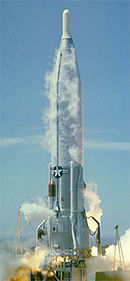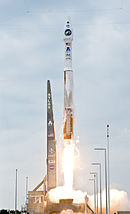AJ-10
 Człon Delta-K z rakiety Delta II, na spodzie silnik AJ-10-188K | |
| Kraj pochodzenia | |
|---|---|
| Projektant | Aerojet |
| Wykorzystanie | Vanguard, Thor Able, Atlas Able, Delta, Titan (Transtage), Shuttle OMS, Apollo Service Module |
| Materiały napędowe | początkowo kwas azotowy i UDMH, później tetratlenek diazotu i Aerozine 50 |
| Pierwszy lot | 1957 |
| Osiągi | |
| Siła ciągu w próżni | 43,7 kN |
| Impuls właściwy w próżni | 320 s[1] |
| Parametry | |
| Komory spalania | 1 |
| Ciśnienie w komorze | 70-90 bar |
| Wymiary | |
| Średnica | 0,84 m |
| Masa | 90-100 kg |
AJ-10 – amerykański silnik rakietowy na paliwo hipergolowe, produkowany przez firmę Aerojet, po raz pierwszy oblatany w 1957 roku. Wykorzystywany był w członach górnych kilku wariantów rakiet Atlas i Thor, a także w rakietach Delta i Titan oraz jako napęd główny statków kosmicznych.
Wybrane warianty silnika
- AJ-10-118 - pierwszy wariant, opracowany dla drugiego członu rakiet Vanguard, jego zapłon po raz pierwszy odnotowano 17 marca 1958, podczas startu satelity Vanguard 1[2].
- AJ-10-101 - wariant dostosowany do ulepszonych wersji członu Able użytego w rakietach Atlas-Able i Thor-Able, pierwszy zapłon w lipcu 1958[3].
- AJ-10-118F - wersja dla członu Delta-F, wykorzystywana w rakietach Delta 0100, Delta 1000[4] i N-II.
- AJ-10-118K - wersja dla członu Delta-K, używana nieprzerwanie od 1989 do chwili obecnej w rakietach Delta II.
- AJ-10-137 - silnik montowany jako główny napęd modułu serwisowego statków w programie Apollo.
- AJ-10-138 - wersja oryginalnie planowana dla rakiet Vanguard, dwukrotnie oblatana w członie Transtage na rakietach Titan.
- AJ-10-190 - jednostki napędowe systemu OMS w wahadłowcach NASA.
Pod rozwagę brano również wykorzystanie AJ-10 jako jednostki napędowej dla statku kosmicznego Orion.
Przypisy
- ↑ Delta II Design. [dostęp 2012-10-10].
- ↑ AJ10-188. Encyclopedia Astronautica. [dostęp 2012-10-10].
- ↑ Thor Able. Encyclopedia Astronautica. [dostęp 2012-10-10].
- ↑ Long Tank Thor-Delta. Space Launch Report. [dostęp 2012-10-10].
Media użyte na tej stronie
The flag of Navassa Island is simply the United States flag. It does not have a "local" flag or "unofficial" flag; it is an uninhabited island. The version with a profile view was based on Flags of the World and as a fictional design has no status warranting a place on any Wiki. It was made up by a random person with no connection to the island, it has never flown on the island, and it has never received any sort of recognition or validation by any authority. The person quoted on that page has no authority to bestow a flag, "unofficial" or otherwise, on the island.
Lift-off of Gemini-Titan 11 (GT-11) on Complex 19. The Gemini 11 mission included a rendezvous with an Agena target vehicle.
Team Vandenberg launched a Titan IV-B rocket from Space Launch Complex 4 East on August 17, 2000. The rocket carried a National Reconnaissance Office satellite into orbit. "The 30th Space Wing, Space and Missile Center, NRO and Lockheed Martin Aerospace have worked together to build upon our legacy of success," said Col. Steve Lanning, 30th Space Wing commander and spacelift commander for the mission. "This marks the 1,800th launch from Vandenberg. We have built a solid foundation for government and commercial space launches from here for years to come." Payload-booster separation successfully occurred at 4:54.15 p.m.
KENNEDY SPACE CENTER, FLA. -- On Pad 17-B at Cape Canaveral Air Force Station, the Delta II second stage is being lifted alongside the mobile service tower. Once inside, it will be mated with the first stage already in place. The Delta II is the launch vehicle for the THEMIS spacecraft. THEMIS consists of five identical probes, the largest number of scientific satellites ever launched into orbit aboard a single rocket. This unique constellation of satellites will resolve the tantalizing mystery of what causes the spectacular sudden brightening of the aurora borealis and aurora australis - the fiery skies over the Earth's northern and southern polar regions. THEMIS is scheduled to launch Feb. 15 from Cape Canaveral Air Force Station.
Trailing a column of fire, the Atlas V(401) carrying NASA's Lunar Reconnaissance Orbiter, or LRO, and NASA's Lunar Crater Observation and Sensing Satellite, known as LCROSS, hurtles off Launch Complex 41 at Cape Canaveral Air Force Station in Florida. LRO and LCROSS are the first missions in NASA's plan to return humans to the moon and begin establishing a lunar outpost by 2020. The LRO also includes seven instruments that will help NASA characterize the moon's surface: DIVINER, LAMP, LEND, LOLA , CRATER, Mini-RF and LROC. Launch was on-time at 21:32 UTC.
Atlas 3F prior to failed launch attempt









